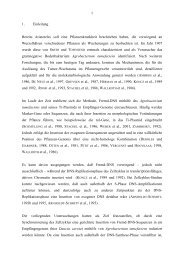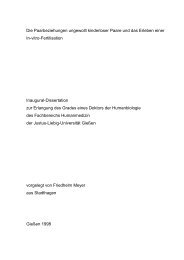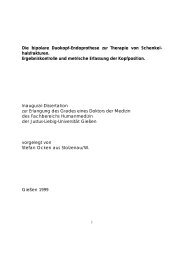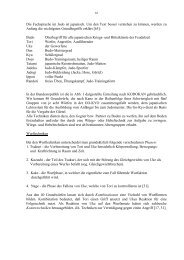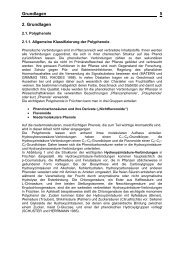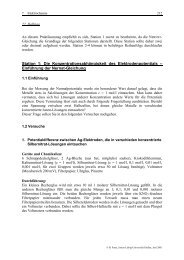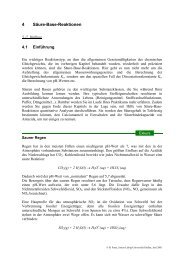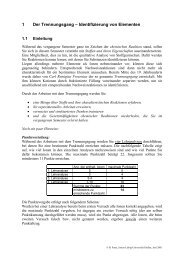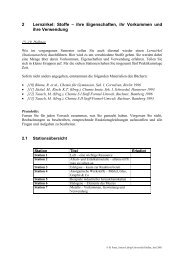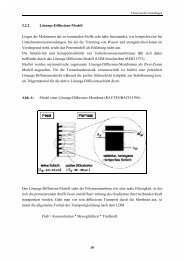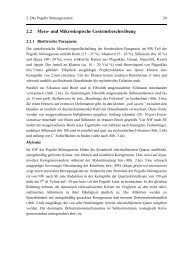Effects of diabaticity on fusion of heavy nuclei in the dinuclear model ...
Effects of diabaticity on fusion of heavy nuclei in the dinuclear model ...
Effects of diabaticity on fusion of heavy nuclei in the dinuclear model ...
Create successful ePaper yourself
Turn your PDF publications into a flip-book with our unique Google optimized e-Paper software.
elements from Z=104 to Z=112 <strong>in</strong> <strong>the</strong> cold fusi<strong>on</strong> reacti<strong>on</strong>s, <strong>the</strong> experimentalists observed a<br />
rapid fall-<str<strong>on</strong>g>of</str<strong>on</strong>g>f <str<strong>on</strong>g>of</str<strong>on</strong>g> <strong>the</strong> evaporati<strong>on</strong> residue cross secti<strong>on</strong>s (about four orders <str<strong>on</strong>g>of</str<strong>on</strong>g> magnitude) with<br />
<strong>in</strong>creas<strong>in</strong>g charge number <str<strong>on</strong>g>of</str<strong>on</strong>g> <strong>the</strong> compound nucleus [7, 8]. In <strong>the</strong> <strong>model</strong> <str<strong>on</strong>g>of</str<strong>on</strong>g> fusi<strong>on</strong> based <strong>on</strong> <strong>the</strong><br />
DNS-c<strong>on</strong>cept, <strong>the</strong> fusi<strong>on</strong> cross secti<strong>on</strong>s and excitati<strong>on</strong> functi<strong>on</strong>s for <strong>the</strong> cold fusi<strong>on</strong> reacti<strong>on</strong>s<br />
lead<strong>in</strong>g to <strong>the</strong> formati<strong>on</strong> <str<strong>on</strong>g>of</str<strong>on</strong>g> super<strong>heavy</strong> elements are obta<strong>in</strong>ed <strong>in</strong> good agreement with <strong>the</strong><br />
experimental data [20].<br />
The structure <str<strong>on</strong>g>of</str<strong>on</strong>g> <strong>the</strong> mass (charge) distributi<strong>on</strong> <str<strong>on</strong>g>of</str<strong>on</strong>g> <strong>the</strong> quasi-fissi<strong>on</strong> products well corresp<strong>on</strong>ds<br />
to <strong>the</strong> peculiarities <str<strong>on</strong>g>of</str<strong>on</strong>g> <strong>the</strong> driv<strong>in</strong>g potential (<strong>the</strong> DNS potential energy as a functi<strong>on</strong> <str<strong>on</strong>g>of</str<strong>on</strong>g> mass<br />
(charge) asymmetry) shown <strong>in</strong> chapter 4. In order to illustrate <strong>the</strong> c<strong>on</strong>necti<strong>on</strong> between <strong>the</strong><br />
quasi-fissi<strong>on</strong> product yield and <strong>the</strong> driv<strong>in</strong>g potential, Fig. 7-4 shows <strong>the</strong> quasi-fissi<strong>on</strong> charge dis-<br />
tributi<strong>on</strong> for <strong>the</strong> reacti<strong>on</strong>s 110 Pd+ 136 Xe (η=0.1), 86 Kr+ 160 Gd (η=0.3) and 76 Ge+ 170 Er (η=0.4),<br />
which lead to <strong>the</strong> formati<strong>on</strong> <str<strong>on</strong>g>of</str<strong>on</strong>g> <strong>the</strong> same compound nucleus 246 Fm. The distributi<strong>on</strong>s reveal<br />
large widths and <strong>on</strong>e can observe a notable drift <strong>in</strong> charge (mass) away from <strong>the</strong> <strong>in</strong>itial charge<br />
(mass) asymmetry <str<strong>on</strong>g>of</str<strong>on</strong>g> <strong>the</strong> <strong>in</strong>teract<strong>in</strong>g <strong>nuclei</strong>. The product masses are substantially different<br />
from <strong>the</strong> target—projectile masses. It is seen that <strong>the</strong> symmetric fragments can be formed<br />
<strong>in</strong> <strong>the</strong> quasi-fissi<strong>on</strong> process if <strong>the</strong> entrance DNS is an asymmetric <strong>on</strong>e. We can observe that<br />
<strong>the</strong> ma<strong>in</strong> peak <str<strong>on</strong>g>of</str<strong>on</strong>g> <strong>the</strong> distributi<strong>on</strong>s is around <strong>the</strong> <strong>in</strong>itial c<strong>on</strong>figurati<strong>on</strong> <str<strong>on</strong>g>of</str<strong>on</strong>g> <strong>the</strong> DNS. Compar-<br />
<strong>in</strong>g Fig. 7-4 with Fig. 4-7a), we observe that <strong>the</strong>re is a correlati<strong>on</strong> between <strong>the</strong> peaks <str<strong>on</strong>g>of</str<strong>on</strong>g> <strong>the</strong><br />
quasi-fissi<strong>on</strong> distributi<strong>on</strong> and <strong>the</strong> m<strong>in</strong>ima <str<strong>on</strong>g>of</str<strong>on</strong>g> <strong>the</strong> driv<strong>in</strong>g potential. The <strong>in</strong>ner fusi<strong>on</strong> barrier Bη<br />
<strong>in</strong>creases with decreas<strong>in</strong>g mass asymmetry η (Figs. 4-1to 4-7b)), while <strong>the</strong> quasi-fissi<strong>on</strong> bar-<br />
rier B qf becomes smaller because <strong>the</strong> Coulomb repulsi<strong>on</strong> <strong>in</strong>creases with decreas<strong>in</strong>g η and leads<br />
to very shallow pockets <strong>in</strong> <strong>the</strong> nucleus-nucleus potential for nearly symmetric c<strong>on</strong>figurati<strong>on</strong>s.<br />
Therefore, <strong>the</strong> decay <str<strong>on</strong>g>of</str<strong>on</strong>g> <strong>the</strong> <strong>in</strong>itial DNS dom<strong>in</strong>ates <strong>in</strong> symmetric or nearly symmetric collisi<strong>on</strong>s.<br />
The experimental fusi<strong>on</strong> probability becomes larger with <strong>the</strong> <strong>in</strong>crease <str<strong>on</strong>g>of</str<strong>on</strong>g> <strong>the</strong> mass asymmetry<br />
η <strong>in</strong> <strong>the</strong> entrance channel [118]. This experimental evidence for a h<strong>in</strong>drance <str<strong>on</strong>g>of</str<strong>on</strong>g> fusi<strong>on</strong> has been<br />
ma<strong>in</strong>ly c<strong>on</strong>cluded from <strong>the</strong> impossibility to produce fermium evaporati<strong>on</strong> residues with nearly<br />
symmetric projectile-target comb<strong>in</strong>ati<strong>on</strong>s [118].<br />
The ma<strong>in</strong> c<strong>on</strong>clusi<strong>on</strong>s are: 1) The quasi-fissi<strong>on</strong> products <str<strong>on</strong>g>of</str<strong>on</strong>g> fusi<strong>on</strong> reacti<strong>on</strong>s are correctly<br />
described with<strong>in</strong> <strong>the</strong> DNS <strong>model</strong>: diffusi<strong>on</strong> <strong>in</strong> charge (mass) asymmetry and <strong>in</strong> relative distance<br />
(<strong>the</strong> DNS decay) coord<strong>in</strong>ates c<strong>on</strong>tributes to <strong>the</strong> yield <str<strong>on</strong>g>of</str<strong>on</strong>g> quasi-fissi<strong>on</strong> products. 2) The quasi-<br />
102



